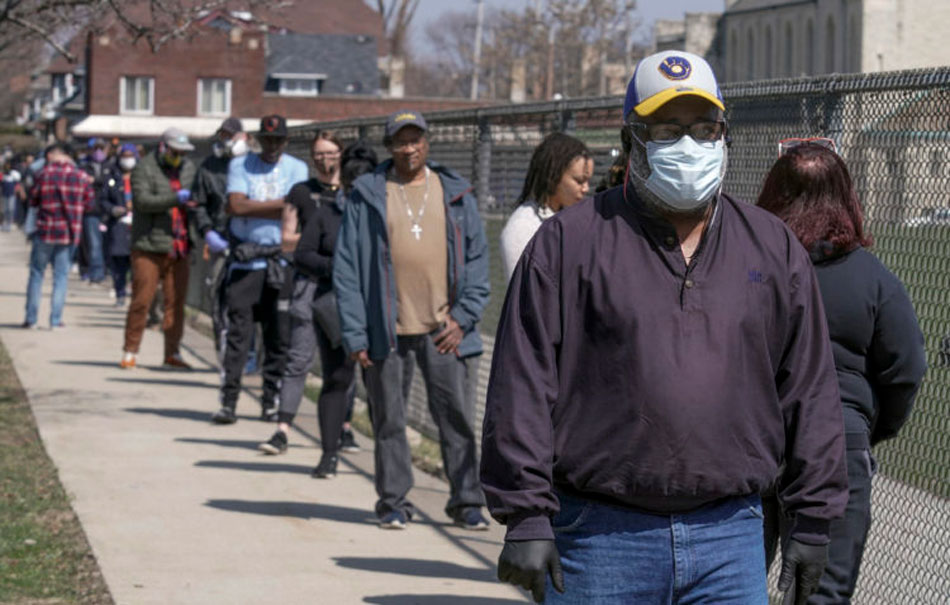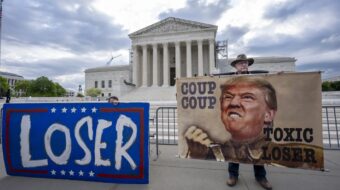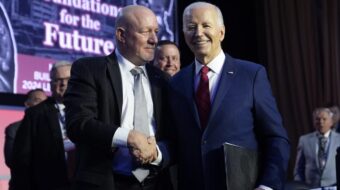
Second, in a three-part series exploring challenges facing the multi-racial labor-people’s democratic coalition that was instrumental in ousting Trump. Part I appeared previously in People’s World.
Joe Biden and Kamala Harris assume office on Jan. 21, 2020, confronting the most significant overlapping set of crises since the Great Depression, beginning with the exploding Covid-19 pandemic, and economic, inequality, and ecological crises. Only large-scale solutions and government intervention can begin to solve these crises.
Consolidating the election victory and addressing these crises occur under complex, changed circumstances. The mass democratic people’s movement instrumental in ousting Trump has an ally in the Biden administration, setting the agenda. Simultaneously, the threat to democracy and the environment and obstruction by the GOP and the extreme right is very much alive.
Many millions live in a media world that creates a narrative that turns reality on its head. As soon as a progressive idea appears and gains popularity the right-wing media goes to work demonizing its supporters and dividing the initially broad array of supporters of the idea against one another.
The Green New Deal is portrayed as an imposition of socialist control aimed at taking away everything from cars to hamburgers. Medicare for All is portrayed as government control of everyone’s life. Ideas that begin by uniting the left, liberals, centrists Democrats, and even some Republicans end up with some of those groups dropping or weakening their support. Fox News, new iterations of it and right-wing social media work overtime doing this.
We live in a big, complicated, and diverse country. Advancing a progressive people’s agenda requires continued employment of what Marxists call “popular front” or “all-people’s coalition” tactics under changed circumstances in which the Biden administration will occupy the White House, Democrats control the House and possibly the Senate, depending on the outcome of the Jan. 5 run-off in Georgia.
Popular front tactics call for building and activating the broad racially diverse labor and people’s democratic and religious coalition, to shift public opinion and mobilize people into action. The labor and people’s coalition act both independently and work through and alongside the Democratic party.
Simultaneously, the alliance must win over as many white voters as possible who, under the influence of racism and right-wing ideology, voted against their class interests and supported Trump and the GOP.
Winning a progressive people’s agenda and eroding the GOP’s power, especially in states and districts they dominate, can only be achieved through a more significant multi-racial working class and people’s unity. The movement must address racism, misogyny, and other right-wing ideas head-on.
Struggling over difference, maintaining unity
The broad political and electoral alliance shares many overall objectives, like universal health care, a sustainable environment, and racial and economic justice. But differences and tensions often arise over how to achieve these goals and due to internal class contradictions.
Tensions spilled out in a post-election meeting of House Democrats to assess the loss of several seats won in 2018 in gerrymandered GOP districts. While some moderates, like Rep. Abigail Spanberger, blamed the losses on progressives, the real reason may lie in Trump’s ability to juice the turnout of his supporters.
Progressives will continue to fight for a Green New Deal and Medicare for All, full racial, gender, LGBTQ equality, and other needed advanced solutions. However, the incredibly diverse assemblage of coalition partners will need to work out differences in ways that strengthen, not weakens, the broad alliance against the extreme right, despite the underlying contradictions.
Political differences reflect the variety of districts Democrats represent. They also signal labor, progressive, and other democratic forces have a way to go to build coalitions and voting blocs capable of eroding the power and resistance of the GOP and ultimately elect Democratic and more progressive candidates.
Popular front tactics while governing
Many anticipate the GOP will set the “machinery of obstruction” into motion against the Biden Administration. In McConnell’s view, “Washington,” in other words, Biden, will get blamed for gridlock, and the GOP will regain the presidency in 2024.
GOP obstruction hides the fact they have no solutions to these crises except free-market capitalism, wealth transfer-up, elimination of labor and environmental protections, dismantling the government and democracy, and austerity. But GOP inaction could spell economic calamity, a concern shared by labor, other democratic movements, but sections of capital too.
Biden has said his will be a “crisis presidency,” reminiscent of FDR, and will propose a large-scale emergency response to the Covid-19 and economic crises. The emergency plan calls for unemployment insurance extension with enhanced benefits, preventing cities and states from going bankrupt, a public health jobs corps, and use of the Defense Production Act to make essential equipment.
This program should resonate with many Trump voters, addressing issues which cross communities, states, and regions. Millions of Biden voters and Trump voters alike are running out of unemployment insurance. They are lining up at food pantries, in danger of missing mortgage payments or rent and risking eviction.
“I’m not sure [they] can sustain the position that we’re not going to do anything to help the circumstances of keeping businesses open, making sure we could open our schools safely,” Biden told N.Y. Times columnist Tom Friedman. “It is kind of hard to go home” if you are a Republican senator who says, “let the states go bankrupt.” Republicans live in those states, too.
States and cities are facing the worst fiscal outlook since the Great Depression. Cuts could result in layoffs to police officers, firefighters, emergency medical technicians, cutting early childhood vaccinations, and closing libraries, parks, and drug treatment centers. Transit systems face devastating cuts. Cuts threaten to close one-third of all cultural institutions. African Americans, Latinos, other workers of color, and women will be significantly affected by public sector layoffs.
These cuts are coming on top of decades of defunding the public sector, education, public health, transit systems and physical infrastructure, and depression level unemployment in Black and Brown communities.
No matter who they voted for, most Americans support funding massive green jobs and infrastructure projects and affordable health care with the public option. Majorities also support a $15 minimum wage, guaranteed family leave, taxing the rich, action on climate, reforming the criminal justice system, gun control, and canceling student debt.
The Biden administration can use executive actions and the bully pulpit to address racial structural inequality, labor, and civil rights, and environmental protections, impacting lives in Black, Brown, and white communities. These actions can affect people living in Republican-dominated states and regions, including rural areas where health care access, rural broadband, jobs and economic development, land use and environment, and food insecurity, are significant issues.
Building multi-racial unity
Expanding the political space needed for the Biden administration to be a “crisis presidency” is a central task of the left, progressive, and multi-racial democratic movement. Building a more vital, more united multi-racial labor and mass democratic people’s movement and expanding its capacity to mobilize and influence public opinion will help determine achievements in the coming period.
And among its central tasks is breaking GOP obstruction by challenging the GOP’s influence and especially addressing the impact of white supremacy and misogyny on white Americans. Battling these poisons is a daily and a long-term struggle, encompassing multiple election cycles and organizing around issues in between.
When white workers vote white racial identity over their class interests, they shoot themselves in the foot and weaken the overall fight to improve life for our entire multi-racial working class and people. However, dismissing all those who voted for Trump and the GOP means giving up on multi-racial working-class unity and the possibility of those influenced by racism to change. Worse, it means abandoning them to the right-wing and a potential mass fascist movement. That, too, is self-defeating.
Building an anti-racist majority
However, the starting point to build an anti-racist majority is the broad multi-racial coalition and diverse voting blocs that elected Biden and Harris. While African American, Latinx, Indigenous, and Asian American voters were decisive to Biden’s victory in battleground states, it took shifts among white voters too. Whites made up 53% of Biden’s votes, part of the inclusive, diverse electorate that propelled him to victory.
90% of African Americans and Indigenous people, 70% of Latinx and Asian Americans, and 41% of whites composed the voting blocs who lifted Biden and Harris to victory. Those whites who voted for Biden and Harris reflect anti-racism and an embrace of a multi-racial democracy. Many have family, friends, and co-workers who voted for Trump.
Another starting point is the belief that people can change, and not all of Trump’s supporters are entrenched white supremacists, xenophobes, homophobes, and misogynists. While one or more of these toxins may influence many whites, they are also reflecting anxiety over changing demographics, the advances in equality, and transformative economic developments, all seething insecurity the GOP is exploiting.
Like most things in life, people are of multiple minds on race, racism, and discrimination. Life events, broader political developments, movements, and new information can impact thinking. The Black Lives Matter protests, the women’s led marches against misogyny, the actions of Dreamers to come out of the shadows, or the LGBTQ community to come out to their families have all had profound impacts on how people think.
The challenges are many, including:
- First, to tap into moral outrage against racism. But those whites who act on morality alone is not sufficient.
- Secondly, raise awareness over the impact of systemic racism and inequality and its toll on people of color and society. Many whites buy right-wing narratives that racism is a thing of the past or an excuse by its victims. The recognition of its existence is the first step in overcoming its pernicious influence.
- Thirdly, convince white workers that while African Americans and other people of color are the targets of racism, it hurts them too, and they have a direct stake in fighting for racial justice. Racism pits worker against worker and weakens the multi-racial working class and people’s ability to fight for what it collectively needs. The quality of life erodes for everyone, only enriching the capitalist class and maintaining political power for the GOP.
- And further, demonstrate the intersection of racial, gender, and economic justice; that the interests of white people generally, and white men, in particular, are aligned with people of color, women, immigrants, and the LGBTQ community. Their future and their family’s future rises or falls with the diverse, multi-racial class and people as a whole.
The challenge before the democratic labor and people’s movement calls for adjusting tactics to fit the new political terrain, building out the structures of engaging, influencing, and mobilizing the multi-racial working class and people’s e movement for a shared future, in the streets, online, and at the ballot box.












Comments